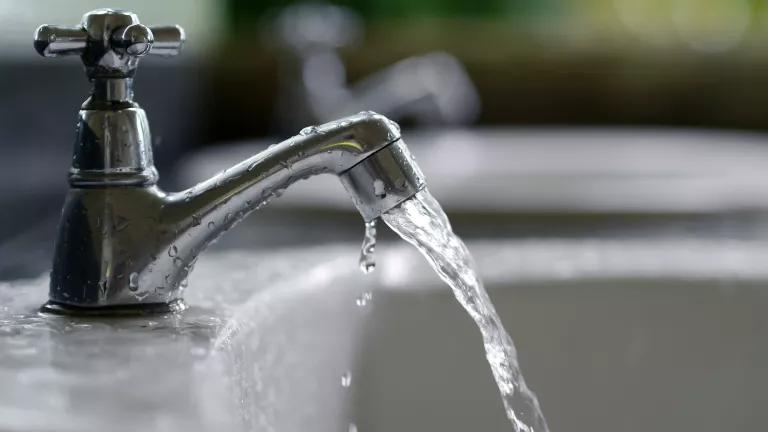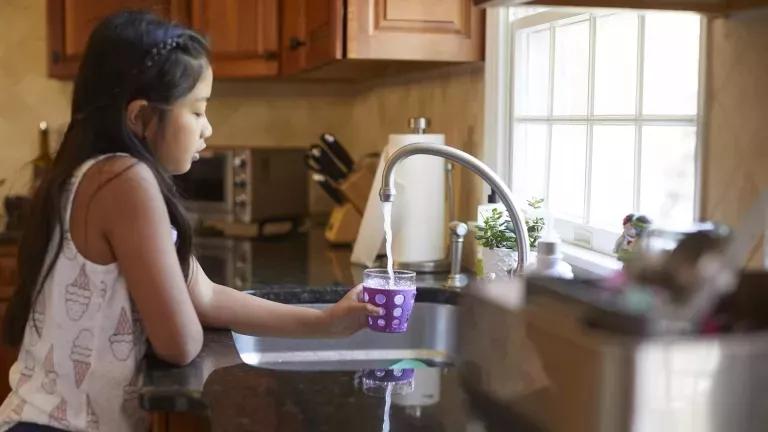How to Protect Yourself from Lead-Contaminated Water
Residents of many cities continue to face high levels of this toxic metal in their drinking water supplies. Here’s what to do if this crisis affects you.

Health experts agree that there is no safe level of exposure to lead. Often making its way into our drinking water supply after leaching from old pipes, the heavy metal can cause serious and irreversible damage to the body—affecting the nervous system, fertility, and cognitive ability, among other functions.
Through the Safe Drinking Water Act, the U.S. Environmental Protection Agency (EPA) requires all community water systems to prepare and deliver an annual water quality report and to take action in the event of lead contamination. Yet some municipalities continue to flout their obligations. Recent NRDC research showed that 186 million people in the country—a staggering 56 percent of our population—drank water from systems with lead levels exceeding that recommended by the American Academy of Pediatrics to protect children.
Until these crises are fully resolved, residents in any city where lead is an issue should take these steps to minimize their exposure.
Check Out Agency Records
Some cities offer public records that can provide you with valuable information—like the locations of lead service lines or the results of lead testing in different regions’ drinking water. Your city may also direct you to reach out to your public water system for these records.
Get Your Tap Water Tested for Lead
Many cities offer this free service to the public. If you’d prefer independent testing, you can get it done by Healthy Babies Bright Futures, which lets you pay whatever you can afford for the test, or check the EPA website to find a certified lab that can perform the testing. Be sure that the lab you choose asks that you collect multiple samples of your tap water.
When collecting samples from a tap for testing, it’s important that you avoid turning on the water in your home for at least six hours prior to sampling. There may be varying instructions from your city or lab on how to collect the samples, but collecting this “pre-flush” sample is a must.
Use Only Cold Tap Water for Drinking
Warm or hot water is more likely to contain elevated levels of lead. Also, do not boil your drinking water—that can concentrate the lead content.
Follow Instructions for Flushing Before Drinking Water
Residents of some cities should heed instructions for flushing water from the tap if it hasn’t been turned on for a number of hours. Check your city’s or water department’s website to determine if there are flushing instructions.
Choose and Maintain Your Water Filter Carefully
Install and use water filters that are certified to remove lead by either the Water Quality Association (WQA) or NSF International (labeled as meeting “NSF/ANSI Standard 53” for lead removal). See this guide for a review of how to pick and operate a filter, and this one for a list of filters that reduce lead levels. Also, be sure to change the filter cartridges regularly, in accordance with the manufacturer’s instructions.
Maintain Your Faucet Aerators, Too
Remove and clean individual faucet aerators, as lead particles and sediment can collect in the aerator screen.
Protect Growing Bodies
To the extent possible, use only filtered or bottled water to prepare baby formula and food. Children and pregnant or nursing women should also use filtered or bottled water for drinking and cooking. Further, parents should consider having their children tested for lead exposure by a pediatrician or other doctor.
If You Can Afford It, Consider Replacing Your Own Pipes and Fixtures
Determine whether you have any lead-containing pipes and fixtures in your home. A certified plumber should be able to help you if you cannot find this out yourself. Replace any indoor household plumbing that may contain lead. If you do install any new household pipes or fixtures, flush the cold water taps afterward.
That said, here’s an important caveat: If you find that the pipe bringing water to your home from the street—the service line—contains lead, do not remove that pipe. The city should remove and replace the entire length of the lead service line, because replacing only part of it could cause lead levels to increase. (Learn more about the problem with partial lead service line replacements here.)
Call City Officials and Legislators
It’s critical to urge those in charge to fix the problem and keep you informed about their progress. Express your concerns and let officials know your city’s lead levels are unacceptable. Finally, contact your state and federal legislators and urge them to fund future water infrastructure improvement projects.
This NRDC.org story is available for online republication by news media outlets or nonprofits under these conditions: The writer(s) must be credited with a byline; you must note prominently that the story was originally published by NRDC.org and link to the original; the story cannot be edited (beyond simple things such as grammar); you can’t resell the story in any form or grant republishing rights to other outlets; you can’t republish our material wholesale or automatically—you need to select stories individually; you can’t republish the photos or graphics on our site without specific permission; you should drop us a note to let us know when you’ve used one of our stories.
Millions of Americans drink tap water served by toxic lead pipes.
Tell the EPA we need safe drinking water!

Tell the EPA we need safe drinking water!
There is no safe level of lead exposure. But millions of old lead pipes contaminate drinking water in homes in every state across the country. We need the EPA to do its part to replace lead pipes equitably and quickly.


What Can We Do to Fix the Drinking Water Problem in America?
“Forever Chemicals” Called PFAS Show Up in Your Food, Clothes, and Home
How to Find Out If Your Home Has Lead Service Lines